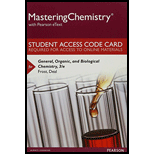
Concept explainers
a.
To determine:
The classification of the given molecule.
Concept introduction:
Cis-Trans isomers come under the geometric isomerism and are a form of stereoisomerism. The prefix “cis” means “on the same side” and the prefix “trans” means “on opposite sides”. When the heteroatom is cis then one heteroatom is at an axial position and the other one is at an equatorial position. When the heteroatom is trans, then both substituents are at the equatorial position but are on the opposite sides of the ring with respect to each other. The Trans isomers have high symmetry and are more stable than cis isomers.
b.
To determine:
The classification of the given molecule.
Concept introduction:
Cis-Trans isomers come under the geometric isomerism and are a form of stereoisomerism. The prefix “cis” means “on the same side” and the prefix “trans” means “on opposite sides”. When the heteroatom is cis then one heteroatom is at an axial position and the other one is at an equatorial position. When the heteroatom is trans, then both substituents are at the equatorial position but are on the opposite sides of the ring with respect to each other. The Trans isomers have high symmetry and are more stable than cis isomers.
c.
To determine:
The classification of the given molecule.
Concept introduction:
Cis-Trans isomers come under the geometric isomerism and are a form of stereoisomerism. The prefix “cis” means “on the same side” and the prefix “trans” means “on opposite sides”. When the heteroatom is cis then one heteroatom is at an axial position and the other one is at an equatorial position. When the heteroatom is trans, then both substituents are at the equatorial position but are on the opposite sides of the ring with respect to each other. The Trans isomers have high symmetry and are more stable than cis isomers.
d.
To determine:
The classification of the given molecule.
Concept introduction:
Cis-Trans isomers come under the geometric isomerism and are a form of stereoisomerism. The prefix “cis” means “on the same side” and the prefix “trans” means “on opposite sides”. When the heteroatom is cis then one heteroatom is at an axial position and the other one is at an equatorial position. When the heteroatom is trans, then both substituents are at the equatorial position but are on the opposite sides of the ring with respect to each other. The Trans isomers have high symmetry and are more stable than cis isomers.
e.
To determine:
The classification of the given molecule.
Concept introduction:
Cis-Trans isomers come under the geometric isomerism and are a form of stereoisomerism. The prefix “cis” means “on the same side” and the prefix “trans” means “on opposite sides”. When the heteroatom is cis then one heteroatom is at an axial position and the other one is at an equatorial position. When the heteroatom is trans, then both substituents are at the equatorial position but are on the opposite sides of the ring with respect to each other. The Trans isomers have high symmetry and are more stable than cis isomers.
f.
To determine:
The classification of the given molecule.
Concept introduction:
Cis-Trans isomers come under the geometric isomerism and are a form of stereoisomerism. The prefix “cis” means “on the same side” and the prefix “trans” means “on opposite sides”. When the heteroatom is cis then one heteroatom is at an axial position and the other one is at an equatorial position. When the heteroatom is trans, then both substituents are at the equatorial position but are on the opposite sides of the ring with respect to each other. The Trans isomers have high symmetry and are more stable than cis isomers.
Want to see the full answer?
Check out a sample textbook solution
Chapter 4 Solutions
Mastering Chemistry with Pearson eText -- Standalone Access Card -- for General, Organic, and Biological Chemistry (3rd Edition)
- The structures below are: A) not isomers.B) conformational isomers.C) cis-trans isomers.D) structural isomers.E) both B and Darrow_forwardIndicate what kind of isomers, if they are, each pair of molecules is.arrow_forwardWhat are stereoisomers? Write a note on cis-trans isomerism citing an example.arrow_forward
 Chemistry for Today: General, Organic, and Bioche...ChemistryISBN:9781305960060Author:Spencer L. Seager, Michael R. Slabaugh, Maren S. HansenPublisher:Cengage Learning
Chemistry for Today: General, Organic, and Bioche...ChemistryISBN:9781305960060Author:Spencer L. Seager, Michael R. Slabaugh, Maren S. HansenPublisher:Cengage Learning Living By Chemistry: First Edition TextbookChemistryISBN:9781559539418Author:Angelica StacyPublisher:MAC HIGHER
Living By Chemistry: First Edition TextbookChemistryISBN:9781559539418Author:Angelica StacyPublisher:MAC HIGHER Introductory Chemistry: An Active Learning Approa...ChemistryISBN:9781305079250Author:Mark S. Cracolice, Ed PetersPublisher:Cengage LearningChemistry: Matter and ChangeChemistryISBN:9780078746376Author:Dinah Zike, Laurel Dingrando, Nicholas Hainen, Cheryl WistromPublisher:Glencoe/McGraw-Hill School Pub Co
Introductory Chemistry: An Active Learning Approa...ChemistryISBN:9781305079250Author:Mark S. Cracolice, Ed PetersPublisher:Cengage LearningChemistry: Matter and ChangeChemistryISBN:9780078746376Author:Dinah Zike, Laurel Dingrando, Nicholas Hainen, Cheryl WistromPublisher:Glencoe/McGraw-Hill School Pub Co





